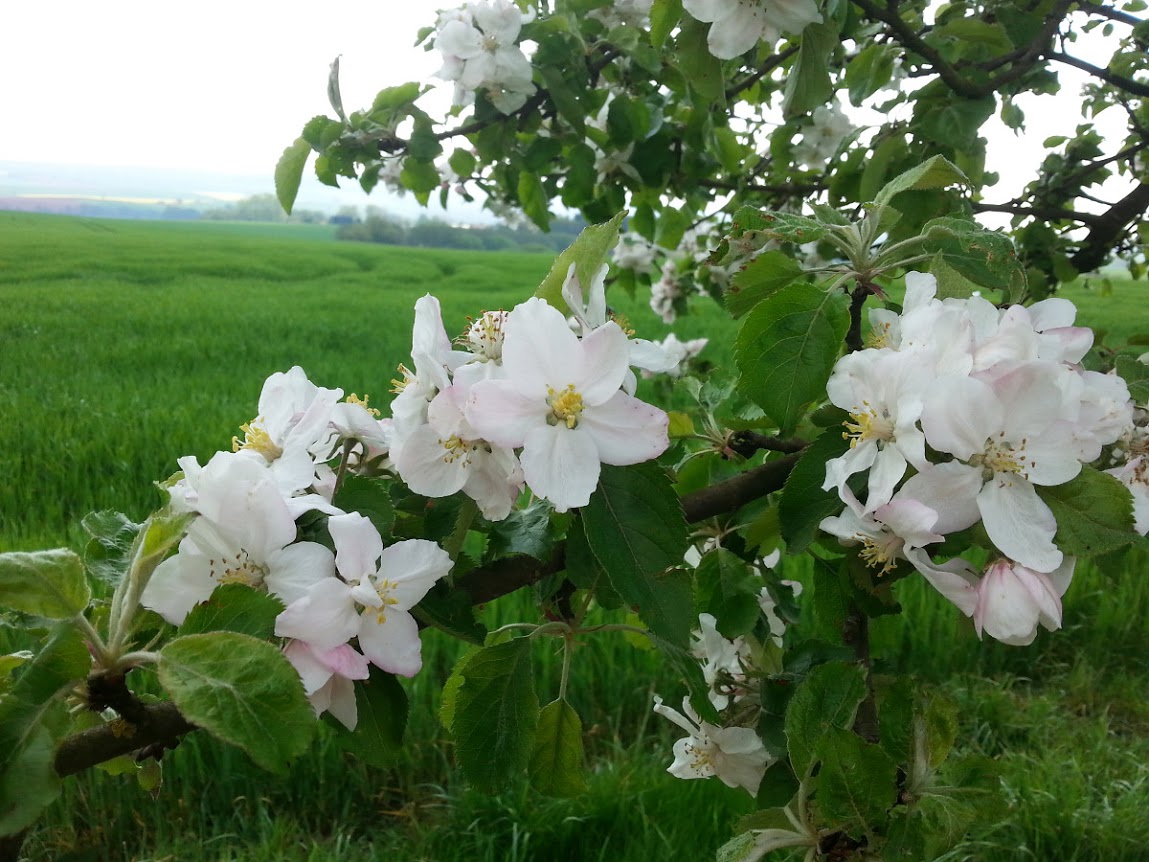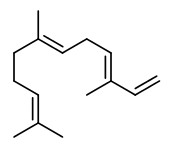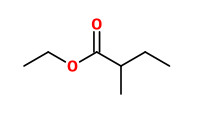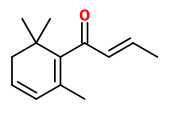Benutzer-Werkzeuge
Malus domestica Borkhausen - syn.Pyrus malus L.; Malus pumila Mill. - Rosaceae - apple, orchard apple, Apfel, Kulturapfel
Deciduous tree, up to 4m (cultivars) or 12m (wild) tall. „The tree originated in Central Asia, where its wild ancestor, Malus sieversii, is still found today. Apples have been grown for thousands of years in Asia and Europe, and were brought to North America by European colonists… There are more than 7,500 known cultivars of apples, resulting in a range of desired characteristics.“ http://en.wikipedia.org/wiki/Apple
Main compound in the headspace of apple flowers was benzaldehyde (13%), followed by geranial (7%) and neral (7%), limonene (5%), 3-carene, α-pinene, terpinolene, benzylalcohol, geraniol, cinnamaldehyde (4% resp.), and α-humulene, 2-phenylethylalcohol, benzyl acetate, and 2-phenylethyl acetate (3% resp.). Minor but olfactory important components were eugenol (1.1%), hexanol, 3-hexenol, linalool, menthol, thymol, vanillin (trace), decanal, β-ionone, bornyl acetate, geranyl acetate, hexyl acetate and 3-hexenyl acetate.
[Buchbauer, Gerhard, et al. „Headspace and essential oil analysis of apple flowers.“ Journal of Agricultural and Food Chemistry 41.1 (1993): 116-118]
„By crushing and chewing in the mouth, very rapid enzymatic conversion of fatty acids lead to the formation of aldehydes like hexanal and 2-hexenal, which are described as green notes (taste of green apples such as Granny Smith).“ http://de.wikipedia.org/wiki/Kulturapfel
α-Farnesene is mainly responsible for the characteristic 'green apple' fruit peel odour like 'Granny Smith'.
[α-Farnesene in the natural coating of apples., Huelin, F.E., Murray, K.E., Nature, Vol.210, 1966, 1260-1261]
The 'Charm' analysis was applied to forty different apple cultivars to examine the sensory impact of apple volatiles. The most intense odor showed β-damascenone (6.5% charm; sweet, perfumy, fruity), revealing that it also contributes to many apple cultivars prior to processing. Hexyl butanoate contributed 5% charm and ethyl butanoate 3.5%, both owning a fruity apple-like odour. Hexyl hexanoate (apple peel-like) contributed 3.5% charm. The study shows that no two cultivars show close resemblance.
„A generalisd description of apple odour produced by combining samples showed beta-damascenone, butyl, isoamyl and hexyl hexanoates, along with ethyl, propyl and hexyl butanoates, to be important to the odour of most cultivars.“
[Charm analysis of apple volatiles., Cunningham, D.G., Acree, T.E., Barnard, J., Butts, R.M., Braell, P.A., Food Chemistry, 19(2), 1986, 137-147]
„Experiments that determined the relative odour activity of volatiles in apples have shown that betweeen 20 and 40 volatiles are responsible for apple aroma. These compounds fall into three classes: the 'apple-peel smelling' esters like ethyl 2-methylbutanoate, the lipid oxidation products like (E)-2-hexenal, and the terpenoid beta-damascenone… Although ripening in apples will proceed either on or off the tree, there are some marked differences between the two… Although ethyl 2-methylbutanoate had the lowest concentrations in both cultivars [McIntosh, Cortland] (2-6ng/g) it could still contribute to flavour because it has a very low odour treshold (0.001ppm). In fact, it has been described as the 'character-impact' odour of Delicious apple. This compound seems to be a postharvest-induced volatile, since it was present in very high concentrations in apples ripened off the tree and after long periods of cold storage. Sensory studies of the odour of 40 apple cultivars ripened on the tree showed that ethyl 2-methylbutanoate contributed less than 1% to their odour. It seems likely that ethyl 2-methylbutanoate is not as important to flavour of fruit ripened on the tree as it is to the flavour of postharvest ripened and postharvest processed apples. Furthermore, its postharvest formation may be induced by low temperature. “
[The evolution of some odour-active volatiles during the maturation and ripening of apples on the tree., Yahia, E.M., Acree, T.E., Liu, F.W., Lebensm. Wiss. Technol, Vol.23, 1990, 488-493]
β-Damascenone (odor threshold of 2 pg/g in water) is an aroma impact compound of heated apple products, due to liberation from precursors. „At least eight separate precursors were found, and the most abundant was further characterized… The most abundant precursor, present at 4.6 ng/g apple (expressed as amount of beta-damascenone liberated under acid hydrolysis), was the 9(or 3)-alpha-L arabinofuranosyl-(1,6)-beta-D-glucopyranoside of the acetylenic diol. The second most abundant precursor, present at 3.1 ng/g apple, is a more polar glycoside of the acetylenic diol.“
[Developments in the isolation and characterization of beta-damascenone precursors from apples., Roberts, D.D., Acree, T.E., In ACS symposium series (USA), 1995]
„Volatile flavour compounds produced by Royal Gala apple have been identified by GC-MS. Major components were 2-methylbutyl acetate, butyl acetate, hexyl acetate, butanol, 2-methylbutanol and hexanol. Odour-port evaluation of the components separated by GC indicated that the first four compounds were important contributors to the aroma and flavour. Use of analytical sensory panels revealed that 2-methylbutyl acetate, butanol and hexyl acetate had the greatest causal effect on those aroma and flavour attributes considered important for Royal Gala apples.“Young, H., Gilbert, J. M., Murray, S. H. and Ball, R. D. (1996), Causal Effects of Aroma Compounds on Royal Gala Apple Flavours. J. Sci. Food Agric., 71: 329-336]
Gravenstein apples at harvest were described as more grassy than stored apples which were sensory characterised by apple, acidic and fresh odour. „The most abundant volatile compounds in Gravenstein were 1-butanol, 2-methyl-1-butanol, 1-hexanol, ethyl butanoate, butyl butanoate, hexyl butanoate, hexyl hexanoate and α-farnesene. The compounds having the highest aroma values (concentration/odour threshold) were ethyl butanoate, ethyl 2-methylbutanoate and ethyl hexanoate. Ethyl butanoate could be an appropriate ripeness-indicator compound in Gravenstein due to its increasing concentration during storage, and its high aroma value. Levels of volatile compounds, especially compounds contributing to the overall aroma, increased during storage.“
[Aaby, K., K. Haffner, and G. Skrede. „Aroma quality of Gravenstein apples influenced by regular and controlled atmosphere storage.“ LWT-Food Science and Technology 35.3 (2002): 254-259]
Elstar and Cox-Orange apple extracts were screened for potent odorants by aroma extract dilution analysis (AEDA).
(E)-β-Damascenone, (E)-β-damascone, hexanal, (Z)-3-hexenal , (Z)-2-nonenal, linalool, butyl acetate, 2-methylbutyl acetate, and hexyl acetate, were identified in Elstar.
(E)-β-Damascenone, hexanal, (Z)-3-hexenal , (Z)-2-nonenal, ethyl butanoate, ethyl 2-methylbutanoate, 1-octen-3-one, (E)-2-octenal, methional, (E)-2-nonenal, eugenol, and wine lactone in Cox Orange.
The release of odorants by the cultivars was analysed by gas chromatography-olfactometry of headspace samples. Ethyl butanoate, ethyl 2-methylbutanoate showed the highest odour activities in the air above Elstar apples and ethyl butanoate, acetaldehyde, 2-methylbutanol and ethyl methylpropanoate in that of Cox Orange. Preparation of a homogenate changed the headspace composition of potent odorants. Hexyl acetate became the key odorant of Elstar and aldehydes hexanal and (Z)-3-hexenal those of Cox Orange. Quantification and calculation of odour activity values indicated (E)-β-damascenone, (Z)-3-hexenal, linalool, butyl acetate, 2-methylbutyl acetate, and hexyl acetate as the character impact odorants of the fruit flesh of the two cultivars. Elstar contained more (E)-β-damascenone, (Z)-2-nonenal, butyl acetate and hexyl acetate and Cox Orange more (Z)-3-hexenal than the other cultivar. The concentrations of 2-methylbutyl acetate were similar.
[Character impact odorants of the apple cultivars Elstar and Cox Orange., Fuhrmann, E., Grosch, W., Food/Nahrung, Vol.46(3), 2002, 187-193]
„Potent apple juice odorants, including 1-butanol, β-damascenone, dimethyl sulfide, ethyl butanoate, ethyl 2-methylbutanoate, hexanal, 1-hexanol, (E)-2-hexenal and 1-octen-3-one were quantified using stable isotope dilution assays in juice and in the aroma fractions thereof obtained by an industrial juice concentration process. Results showed a distinct loss of the major juice aroma component β-damascenone during juice concentration. High losses were also found for dimethyl sulfide and 1-octen-3-one.“
[Key aroma compounds in apple juice-changes during juice concentration., Steinhaus, M., Bogen, J., Schieberle, P., Developments in Food Science, Vol.43, 2006, 189-192]
The fifteen principal odorant compounds detected by >=75% assessrs in aroma extracts of Golden Delicious, Fuji, and Braeburn apples were 2-methylpropyl acetate (pear, apple, fruity), ethyl butanoate (fruity apple strawberry), ethyl 2-methylbutanoate (fruity, strawberry), butyl acetate (fruity), hexanal (green), 2-methylpropanol (plastic), 2-methylbutyl acetate (fruity sweet apple), butyl propionate (red fruits strawberry), (Z)-3-hexenol (fresh green apple), butyl butanoate (rotten fruits), 2-methyl butanoate (fruity apple), hexyl acetate (sweets pear), hexanol (fresh green), camphor (camphor pine), and octanol (grass).
„… the overall quantity of the selected volatiles increased during maturation for Fuji and Golden Delicious apples [and decreased for Braeburn]… The most significant increase in Golden Delicious apple extracts was observed for butyl acetate, 2-methylbutyl acetate, (Z)-3-hexenol, 2-methylbutyl butanoate, and hexanol, and concerned the late harvest fruits. In fuji apples, this increase was optimal for fruits harvested in Otober (at commercial maturity) and concerned the same volatile compounds, the most predominant compound being 2-methylbutyl acetate… A significant correlation coefficient was found between the aroma intensity scores and overall quantity of the odorant volatiles… The aroma intensity scores were the most significantly correlated to the quantity of hexanal, butyl acetate, and 2-methylpropyl acetate…“
[Mehinagic, Emira, et al. „Characterization of odor-active volatiles in apples: influence of cultivars and maturity stage.“ Journal of Agricultural and Food Chemistry 54.7 (2006): 2678-2687]
Methyl 2-methylbutanoate [FD 2344] and ethyl 2-methylbutanote [FD 3336] with very low odour detection thresholds in air (~1ng/l) were considered the most potent odorants of the very aromatic Fuji apple (cross between Red Delicious and Rawls Jennet). Further volatiles with high Flavor Dilution (FD) factors were isobutyl acetate, ethyl butanoate, isopentyl formate, butyl acetate and hexyl acetate as well as hexanal.
[Determination of potent odorants in apple by headspace gas dilution analysis., Komthong, P., Hayakawa, S., Katoh, T., Igura, N., Shimoda, M., LWT-Food Science and Technology, 39(5), 2006, 472-478]
The key aroma compounds (following the odor activity value = OAV concept) of Golden Delicious apple juice were β-damascenone, hexanal, diacetyl, acetaldehyde, dimethyl sulfide, (Z)-1,5-octadiene-3-one, (E)-2-hexenal, (Z)-3-hexenal, ethyl 2-methylbutanoate, methional, 1-octen-3-one, 1-butanol, methyl 2-methyl-butanoate, 1-hexanol and linalool. Regarding cloudy raw juice, OAV's were higher than of clear juice. OAV's of important odorants were much higher in raw juice than in apples with the exception of 1-octen-3-one and (Z)-1,5-octadiene-3-one. Pasteurization lead to increasing OAV's of β-damascenone, dimethyl sulfide, (Z)-1,5-octadiene-3-one, and 1-octen-3-one, and decreasing 'green' odorants like hexanal, (E)-2-hexenal, and (Z)-3-hexenal.
[Steinhaus, M., Bogen, J., Schieberle, P., From apple to juice - Changes in key aroma compounds during processing. In Recent Highlights in Flavor Chemistry & Biology, Proceeding of the 8th Wartburg Symposium on Flavor Chemistry and Biology. Deutsche Forschungsanstalt für Lebensmittelchemie, Eisenach, 2008, 123-128]
„In ripe apples, alcohols constitute 6 to 16 % of the total volatiles, whereas esters represent, depending on the apple variety, from 80 % in Golden Delicious and Golden Reinders to 98 % in Starking Delicious… Butyl acetate, hexyl acetate, 2-methylbutyl acetate and ethyl 2-methyl-butanoate are the most important esters due to their high content and impact on apple aroma of several varieties.“
[Espino-Díaz, Miguel, et al. „Biochemistry of apple aroma: A review.“ Food technology and biotechnology 54.4 (2016): 375-394] https://hrcak.srce.hr/169971
„Aroma extract dilution and gas chromatography–olfactometry analyses revealed that hexyl 2-methylbutyrate, α-farnesene, 1,3-octanediol, hexanal, (E)-2-hexenal, hexanol, butanol, and 2-methyl-butanol are the most potent odor compounds in ‘Honeycrisp’apple. Aroma reconstruction and omission tests combined with sensory analyses suggested that hexyl 2-methylbutyrate is responsible for the strong fruity note of ‘Honeycrisp’ apple, and that other alcohols, aldehydes, and α-farnesene are essential for its background aroma notes.“
[Yan, Dan, et al. „Insights into the aroma profiles and characteristic aroma of ‘Honeycrisp’apple (Malus× domestica).“ Food Chemistry 327 (2020): 127074]
„…apple industrial aroma, obtained under the concentration step of juice and recovered by evaporation/distillation, can be stored in closed containers at room temperature without noticeable loss of volatile compounds, and not requiring refrigeration. 1-Butanol, trans-2-hexenal, hexanal, ethyl 2-methylbutanoate, and ethyl acetate are key compounds that can be diagnostic of product quality due to their stability, maintaining the Aroma Index under the industrial process and during storage at room temperature. Four independent industrial productions from two distinct harvesting seasons showed similar Aroma Index among the key compounds, with the compound ethyl 2-methylbutanoate the highest contributor to apple scent with an Aroma Index 100,000-fold higher than its odor threshold.“
[Coelho, Elisabete, et al. „Concentrate Apple Juice Industry: Aroma and Pomace Valuation as Food Ingredients.“ Applied Sciences 11.5 (2021): 2443.]

Thomé, O.W., Flora von Deutschland Österreich und der Schweiz, Tafeln, vol.3, t.421 (1885)
http://plantgenera.org/species.php?id_species=637498

Malus domestica flowers, CC BY-SA 3.0, Author: Andreas Kraska



